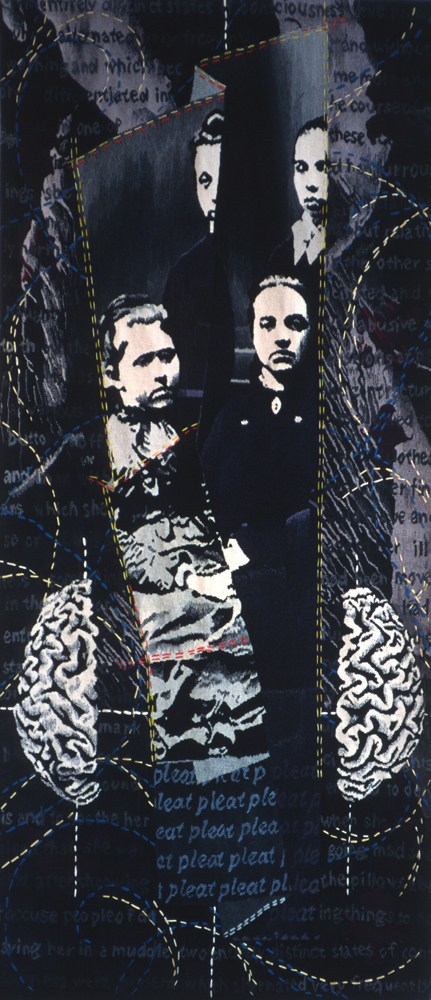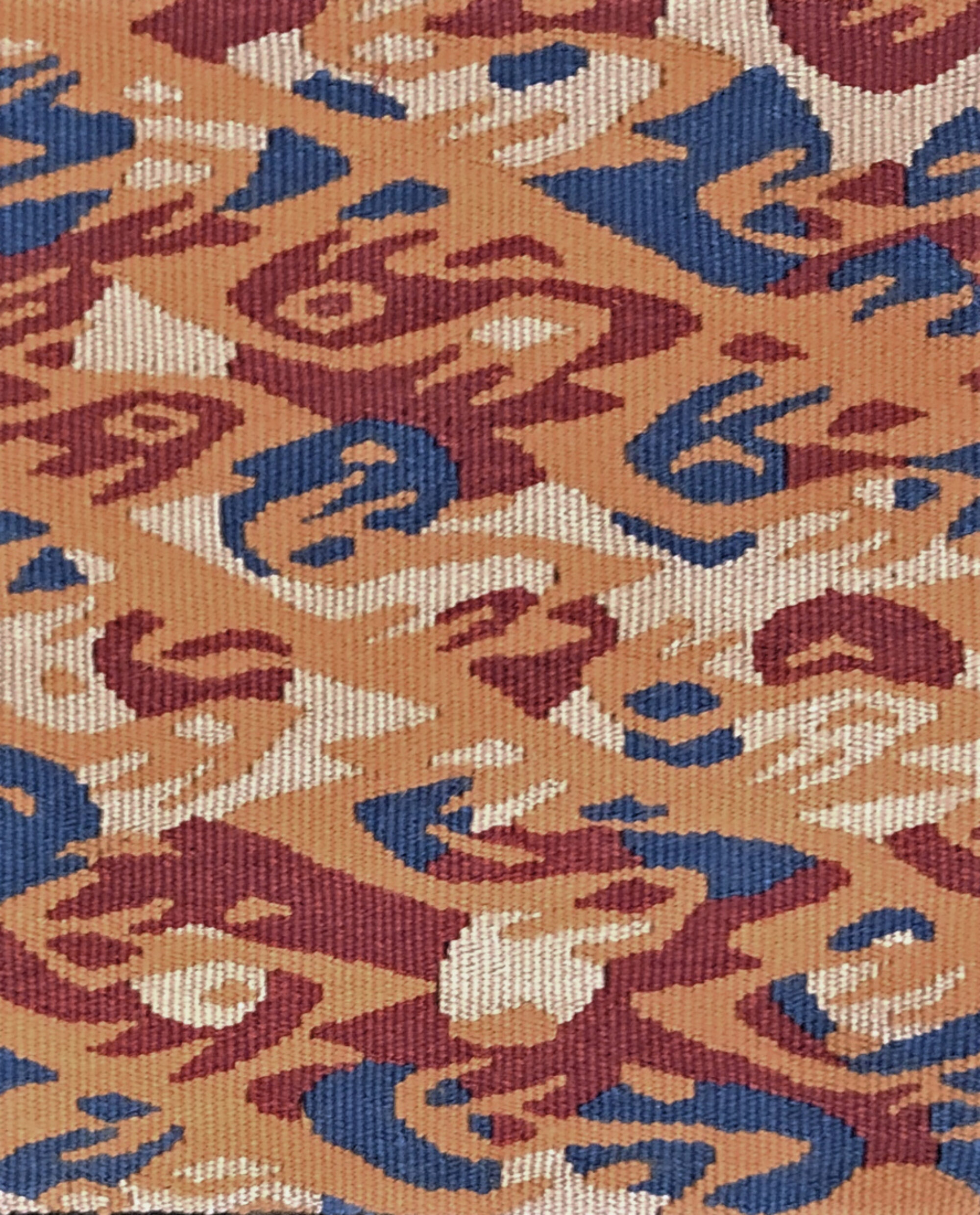This article was first published in the International Tapestry Journal. Vol. 2, No. 3. Fall 1996.
Eugenia Bush was born in 1862 into a wealthy Salem, Oregon family, the youngest daughter of Eugenia and Asahel Bush, newspaper publisher and politically influential pioneer. In 1994 Shelly Socolofsky became the caretaker of the Bush family house, which is now owned and maintained by the city of Salem and operated as a museum by the Salem Art Association. In the process of reading about the Bush family Socolofsky discovered that Eugenia, an artist who was seldom referred to in family writings, had been diagnosed, in her late teens, with mental illness, probably schizophrenia. Socolofsky feels that her discovery of Eugenia involved more than coincidence and this deeper connection has provided the impetus to develop a series of tapestries probing human consciousness, one of which is entitled Pleat.
The image of Pleat is based on a collage. Pablo Picasso is credited with creating the first collage as high art. In Still Life with Chair Caning Picasso glued a piece of oilcloth which had been printed with a caning pattern onto his canvas, hence the real name collage (Fr, glued). The technique is considered significant because it offers additional technical possibilities in the construction of an image, allowing for the inclusion of objects themselves, not just the painted or drawn illusion of objects. Robert Rauschenberg and Jasper Johns later exploited collage as a commentary on Abstract Expressionism’s abhorrence of illusionism, and their work served as a springboard for much of the postmodern use of borrowed images and multimedia techniques. Collaging actual objects onto a picture plane questions the distinction between what seems to be real (the drawn illusion), and what is considered to be real (the object itself). Borrowing images questions notions of creativity, rejects the modernist preoccupation with progress and novelty and establishes a dialogue with the past. It is these aspects of the collage that are meaningful in considering Socolofsky’s work.

The maquette for Pleat combines historical photos of the Bush children (Eugenia is on the bottom left) with written text and linear elements. The photo of the Bush children is folded -pleated into a shape which suggests clothing patterns. Pleats, along with darts and tucks, are ways of ornamenting clothing and making it fit. Clothing patterns come in prescribed sizes and styles, sizes and styles which are considered normal and socially acceptable. In the tapestry the clothing patterns become symbols for socially accepted patterns of behavior, patterns which Eugenia was unable to follow. The pleating of the photo also creates a disjunction which hides part of the image, a break between the left and right, analogous to the two hemispheres of the brain which, in schizophrenia, are considered to be at odds with one another. This split is reiterated in the divided image of the cerebral cortex, which flanks the photo. The hidden portion of the pleated photo can be seen as an analogue to psychological repression, the denial of certain experiences or feelings which do not have a socially acceptable avenue for expression.
The text which runs through the images is taken from Freud’s case studies, clinical examples of hysteria and mental illness which serve as the basis for our understanding of the human psyche. The diagnoses made from these cases are, like the clothing patterns, generalizations – generalizations about the nature of the human mind and about patterns of mental health and patterns of mental illness which serve to classify and group people into prescribed boundaries. Recent feminist scholarship has pointed to the ways in which Freudian thought limits female psychology and behavior into normal ranges. Females are characterized as emotional instead of intellectual, passive instead of aggressive, and biologically prone to hysteria.
Together, the text and the photo provide us with a glimpse into Eugenia’s outer, physical form and her inner, emotional self. In the image the inner and the outer are presented as different surfaces, different textures upon a plane, rather than discrete and disconnected realms of consciousness. The boundary between them is established by lines of stitching which surround the pleated photograph – the surrogate clothing pattern – the symbol for societal norms. However, the boundary between the inner and outer world is what, in the case of mental illness, is often breached and indeed, in the image, the cohesion of a single flat surface is broken by the fold of the pleat. This break reminds us that the fit between an individual and a psychoanalytic theory is only approximate and that the play between the inner and outer consciousness is, ultimately, more complex and multi-dimensional. The pattern never quite fits. It is perhaps, the stitching that gives us an element of hope. For although this stitching binds the pattern, it also breaks free to wander across the surface, creating unbounded spaces which open up for a space for difference. It is also in the stitching that color is introduced, breaking free from the formality and flatness of the predominantly black and white surface.
As mentioned above, the use of found images, such as the historical photo and the anatomical drawing, and of borrowed text is a postmodern strategy which considers the author not as the creator of something new and original, but rather as a collaborator with the already existing. In this sense collage becomes a vehicle for bringing together bits of information which can be reinterpreted in view of the relationships that are created within the collage. In Pleat Eugenia’s life can be seen in the broader context of what is considered normal an abnormal. By presenting her life amidst clothing patterns and Freudian theories, Socolofsky shows us how societal expectations urge us in certain directions and attempt to hide from public view those who deviate.
The content of the image finds additional dimension within the textile medium. Not only does the cloth of the tapestry itself refer to the clothing patterns which Socolofsky uses as a metaphor for social norms, it also serves to literally bind the elements of the collage, which in the maquette, are still simply separate fragments. Collage, by its very nature suggests complexity and interrelationships. It facilitates the juxtaposition of the discrepant – the text and the image, the flat and the dimensional, the inner and the outer. However, it is the steady under, over, under, over over of the weaving that unifies this image to an extent not found in the collage maquette. The marriage of the various elements is realized through the weaving.
The stitching, or flying shuttle, also refers to binding – the binding of the collage and the binding of individuals within society. However, as the erratic and multidimensional nature of the stitching on the tapestry seems to suggest, individual lives have their own directions, directions which often, as in the case of Eugenia , deviate from the range of recognizable, or acceptable patterns.
In presenting Eugenia, Socolofsky attempts to come to terms with the discontinuities that exist in peoples’ lives, discontinuities within one’s own psyche and those that single people out as different from others. In presenting a multilayered allegory of Eugenia’s life, she asks the past, and in particular, the life of one woman, to answer questions about the present, to help us understand ourselves through others.
